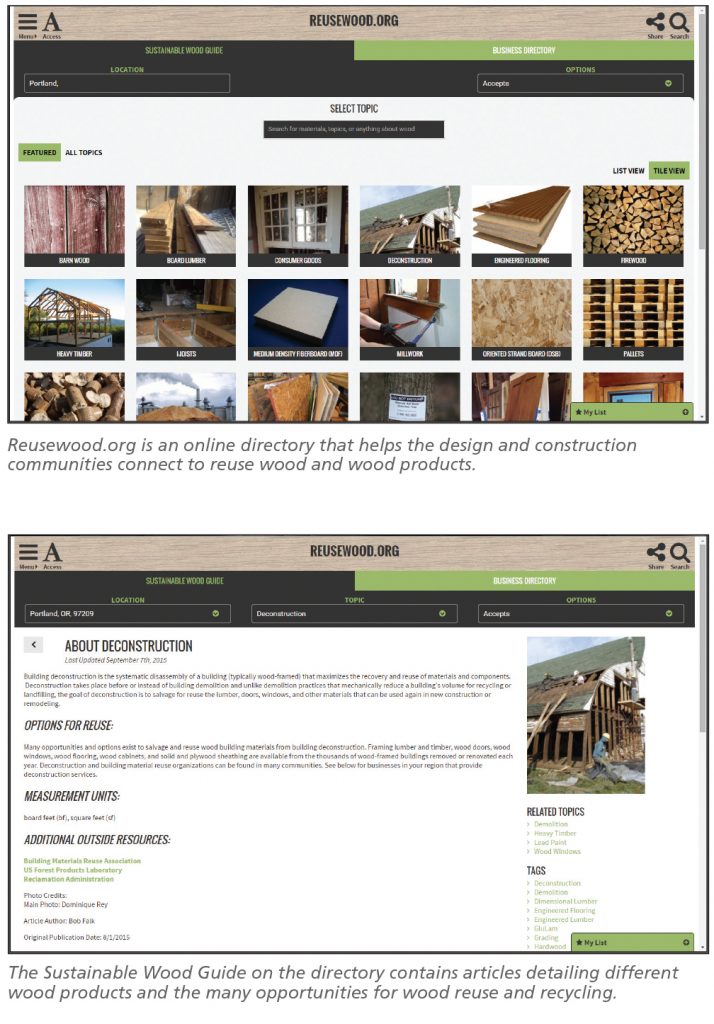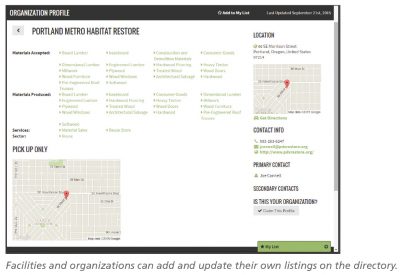This story originally appeared in the April 2016 issue of Resource Recycling.
Subscribe today for access to all print content.

While America is steadily increasing the amount of refuse that gets properly recycled or reused, there is still work to be done. Wood is one area for potential advances.
Today, builders and homeowners alike are looking more toward reusing and recycling green materials, such as wood and wood products, to reduce the carbon footprint of the built environment. When it comes to wood products – which fall under the organic material category, the largest component of municipal solid waste (MSW) – less than 3 percent gets recovered from previous projects and uses. This contributes to the U.S. sending more than 50 percent of its MSW to landfills.
Reusing materials such as wood can help to significantly reduce what ends up in the waste stream and help to conserve natural resources. To do this, developing infrastructure is critical. The environmental benefits of reusing and recycling building materials have become more obvious over the years. What’s less clear to residents and businesses is how to properly recycle wood products at the end of their useful life as well as how to source reclaimed materials for new building projects.
Finding wood on the web
To help facilitate the wood recovery process, the American Wood Council (AWC) and Canadian Wood Council (CWC) partnered with the Building Materials Reuse Association (BMRA) to develop the Reuse Wood Directory (reusewood.org), which outlines an abundance of reuse and recycling options for wood and wood products. The website’s aim is to make it easy to find facilities accepting or providing reclaimed lumber products.
The Reuse Wood Directory includes a comprehensive business directory of companies involved in recycling and reuse of the material, and it includes an easily accessible interactive map that makes sourcing a breeze. It also provides individual listing pages that provide contact information, location and available services for each business. In addition, the site includes a sustainable wood guide that contains useful information and articles detailing different wood products and the many opportunities for wood reuse or recycling.
Given that the planet has limited natural resources, the choice of products used to build and renovate has a significant impact on the environment. Although wood is a renewable natural resource, it’s important to consider the full life cycle of environmental impacts when deciding which building products to utilize. Salvaging and reusing wood and wood-based products ultimately helps reduce what goes into the construction waste stream, reduces the need for landfill space and provides opportunities for second lives for products that do not yet need to be disposed. In fact, a considerable amount of wood used in construction (such as formwork and bracing) can be salvaged and reused. The directory’s Sustainable Wood Guide offers a building demolition section that illustrates methods for reusing wood from dissembled structures.
Navigating the directory
The individual listing pages on the site provide detailed descriptions of solution providers included with each of the wood products featured in the sustainable wood guide. The listing pages include the following:
- A detailed description of the materials accepted
- A complete list of materials produced by the vendor
- The sector of reuse in which the vendor specializes
- Preferred transportation method for delivering or recovering salvaged wood products
Navigating the Reuse Wood Directory website is simple. For those looking to recycle a wood product or have it reused, the site allows for searching within a particular region and links users with vendors capable of producing mulch, woodchips, shavings or other materials. Users looking to find a recycled or reused product can use the directory’s search abilities in the same way. The directory also notes if providers are able to deliver the wood or offer a pick-up service.
 By making reclaimed wood products more easily accessible, the directory is helping builders reduce the overall environmental impact of buildings and take advantage of the large amount of existing wood materials readily available. A building disassembly team might use the website to identify and contact a nearby recycling vendor in order to responsibly dispose of wood products from the demolition. Or builders hoping to find locally recycled wood for a feature wall can use the directory to find a specific reuse dealer in their area.
By making reclaimed wood products more easily accessible, the directory is helping builders reduce the overall environmental impact of buildings and take advantage of the large amount of existing wood materials readily available. A building disassembly team might use the website to identify and contact a nearby recycling vendor in order to responsibly dispose of wood products from the demolition. Or builders hoping to find locally recycled wood for a feature wall can use the directory to find a specific reuse dealer in their area.
One prime example can be seen in the practices of Phoenix Commotion, a Texas-based construction business operated by architect Dan Phillips. The company sources recycled wood and other materials to create affordable homes for low-income or first-time buyers. Phillips and his team of builders use scrap wood that is locally sourced to build these homes. The first house Phillips built was the Tree House, a remarkable home constructed entirely from scrap wood and leftover tree branches.
The Reuse Wood Directory can help others source materials for similar projects by locating urban wood debris from storm activity, construction or demolition that would otherwise be discarded in landfills.
AWC, CWC and BMRA are continually working to expand the network of vendors available in the directory.
State by state
The Reuse Wood Directory also offers various resources that focus on the state level, providing information about recycling wood and encouraging residents to utilize urban and municipal wood to reduce the carbon footprint of building efforts.
Users in Illinois, for instance, can find groups like the Illinois Wood Utilization Team (WUT), which helps state residents harvest and use wood from urban and community-felled trees. Horigan Urban Forest Products is another wood recycling vendor in Illinois that recycles urban forest residuals and uses them to produce numerous other products. The vendor uses the same trees that are typically tossed for firewood or mulch to make commercially sellable hardwood lumber.
In Southeast Michigan, meanwhile, residents recently experienced an infestation of the emerald ash borer in local ash trees, causing large branches of the tree to die faster. Trees such as these present a great opportunity for reuse and recycling. To help educate residents about reusing and recycling diseased wood, the Reuse Wood Directory shares information about the Ash Utilization Project, developed by the Southeast Michigan Resource Conservation and Development Council to address the problem. The initiative shares ways to reuse and recycle infested wood through training sessions, a research program and demonstration projects.
The directory also showcases vendors that recycle products that typically are difficult to get rid of or create sustainably. For example, A Step Above Stables, a horse ranch in Georgia, accepts wood products and uses them to help riding enthusiasts build sustainable horse stables. The ranch also produces mulch and woodchips.
 In addition, local chapters of Habitat for Humanity accept salvaged wood products for use in their homebuilding projects. One example is the Cedar Valley Habitat for Humanity in Iowa, which utilizes a wide variety of building materials to help build homes for lower income residents.
In addition, local chapters of Habitat for Humanity accept salvaged wood products for use in their homebuilding projects. One example is the Cedar Valley Habitat for Humanity in Iowa, which utilizes a wide variety of building materials to help build homes for lower income residents.
Meeting sustainability objectives
The use of recycled materials is a great way to help reduce the carbon impact of the built environment and to meet ambitious green objectives for building projects both big and small. With more resources like Reuse Wood Directory becoming available, builders, designers and consumers will no longer have to sacrifice convenience to make a positive impact on the environment.
The wood-products industry is committed to environmental stewardship and believes there are many opportunities for its products at “end of first life.” Wood products are cost-effective and renewable resources that can be used again and again to help to achieve environmental balance – and the Reuse Wood Directory is a resource that can help achieve this.
Heather Stegner is the senior director of communications at the American Wood Council. She can be contacted at [email protected]

